My thoughts on markets and money-Balance
Although 2024 double-digit stock market return suggests a strong US economy, the recent change in government leadership and policies highlights the underlying risk (uncertainty) that now weighs down the market and tests American exceptionalism.
The way of the sage is to act but not to compete.
(Lao Tzu)
History Lesson
As an Asian kid growing up in the Midwest in the early 80s, I often felt like an outsider. So, throughout life, I’ve naturally gravitated towards outsiders. Within the investment world, arguably one of the biggest outsiders is Jeremy Grantham. Co-founder and former chief investment strategist of investment firm GMO, Grantham is an idiosyncratic, octogenarian billionaire. A long-time student of market bubbles, he often correctly calls out bubbles, albeit a few years early: Japan market bubble (1989); dot.com bubble (1999); housing market bubble (2007); US equity bubble (2021). Unlike his contemporaries, Grantham says it like he sees it and rarely bows to pressures, even at great professional and financial costs.
For example, in 1997, Grantham began sounding the alarm on the dot.com bubble and ordered his investment team to reposition their portfolios for a downturn. Unfortunately, the US stock market continued accelerating upwards for the next 2 years and delivered back-to-back double-digit returns: 1998 (16%) and 1999 (25%). For missing out, GMO was punished by its investors, who withdrew half of asset under management (AUM). Bloodied but unbowed, Grantham ordered his investment team to double-down on their position in preparation for (now) a steep downturn. Beginning March 2000, the dot.com bubble finally burst and continued its decline for the next 3 years. In the process, the Dow declined by 27% while the expensive, tech heavy NASDAQ declined by 78%. (Fun fact: Amazon dropped by 92%.) Grantham helped GMO and its remaining clients side-step the brutal bear market and delivered a higher return than the S&P 500 on the round trip (boom-bust-boom).
Where are we?
The breaking of the US stock market throughout 2022 reversed course with the introduction of ChatGPT (late-2022) and the dawning of Artificial Intelligence (AI). As with the introduction of any new invention/technology, investors got excited, and then they got aggressive (again). Their assumption: recognizing a new technology is the same thing as profiting from it. (See line graph below. Introduction of new technology and the ensuing stock market boom and bust: high-speed rail (early 1900s); mass production of automobiles (1920s); television (1950s); internet (1990s).)
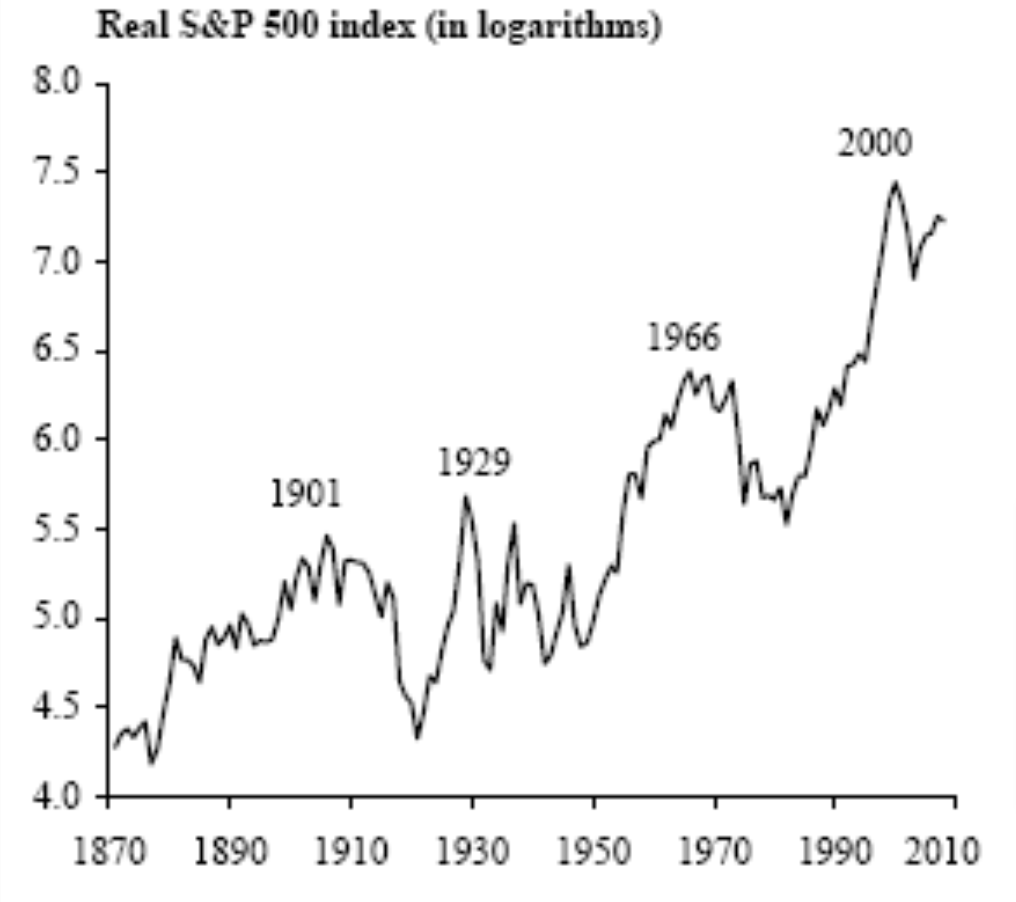
Source: “Speculative Bubbles and Overreaction to Technological Innovation,” Federal Reserve Bank of San Francisco, 2008
The raging debate over a soft or hard landing quickly morphed into no landing. In 2023, the US stock market, led by the Magnificent 7 (Apple, Microsoft, Google, Amazon, Nvidia, Meta, Tesla), pulled off a financial anomaly: strong return (24%) despite higher interest rates (5%). By 2024, fear of missing out (FOMO) pulled those who were still on the sidelines back into the (bull) market. By year-end, investor enthusiasm helped drive the US market to an amazing 23% return. Uncertainty, pessimism and humility were replaced by certainty, optimism and complacency. Talking heads concluded: One can’t afford to be out of the US market.
Beginning 2025, a Democrat-led government changed to a Republican-led government. This has resulted in a sharp shift in domestic and international policies, which has helped highlight the great uncertainties underlying the US stock market (expensive and unstable); US economy (uneven and unequal – haves vs have nots); US global commitment/investment (extensive and expensive).
Potential risks
Investing is a game of probability: risk vs return. But, oftentimes, most investors assume that the higher the stock market climbs, the safer it is and the greater their probability of earning high returns. However, in reality, it’s actually the inverse of that. Personally, I find it helpful to visualize the stock market as a game of Jenga. A wooden block game, in Jenga, players take turns pulling out a wooden block from the lower tier and then restacking it at top of the tower. Goal is to build an increasingly higher tower without toppling it. The higher the tower, the more unstable it becomes and the greater the risk that the next player will topple it. Inevitably, one will and, thus, losses the game. But, unlike players in Jenga, late-comers to a stock market (bubble) lose real money, because they’d bought shares at their most expensive. With that visual in mind, let’s look at some of the key risks investors should be mindful of moving forward.
First, the US stock market continues to be very expensive compared to historical average. According to Shiller PE (price per earnings), the S&P 500 carries a PE of 35 (ending March 18, 2025 – below). What this means is that it costs an investor on average $35 to buy $1 of (future) earnings from the collective US companies. Historically, it costs an investor on average $16 to buy $1 of (future) earnings. So, currently, US stock market is 2xs more expensive than its historical average. Two occasions when it was more expensive are dot.com (43) and 2021 (38).
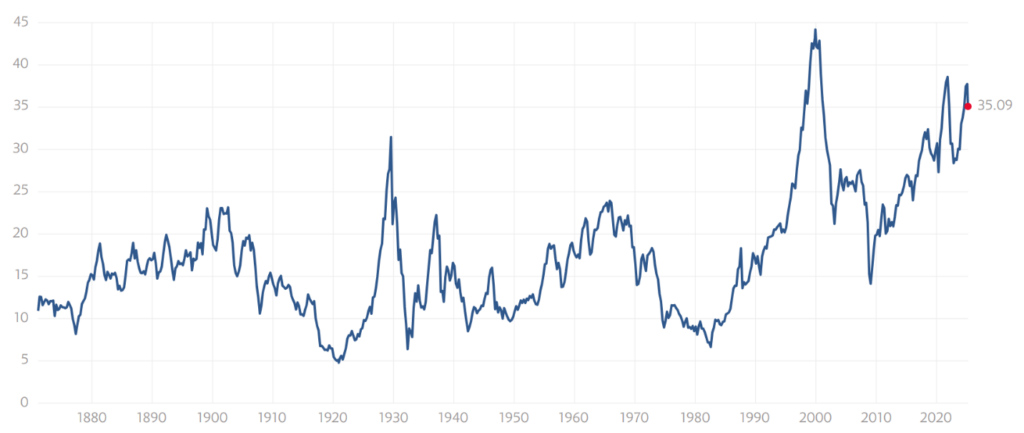
Source: https://www.multpl.com/shiller-pe
Second, inflation remains stickier than previously thought. During the COVID pandemic, a combination of low supply and high (government) stimulus propelled inflation from a multi-decade low of ~2.5% to 9% (June 2022). In response, the Fed’s aggressive raising of rates from 0% to 5% (April 2022 – August 2023) helped bring inflation down to ~3.5% where it has hovered for the past 9 months. Now, some of the Republican policies (e.g., tariff) could undo the Fed’s progress and, thereby, derail its effort in reaching inflation target of ~2%.
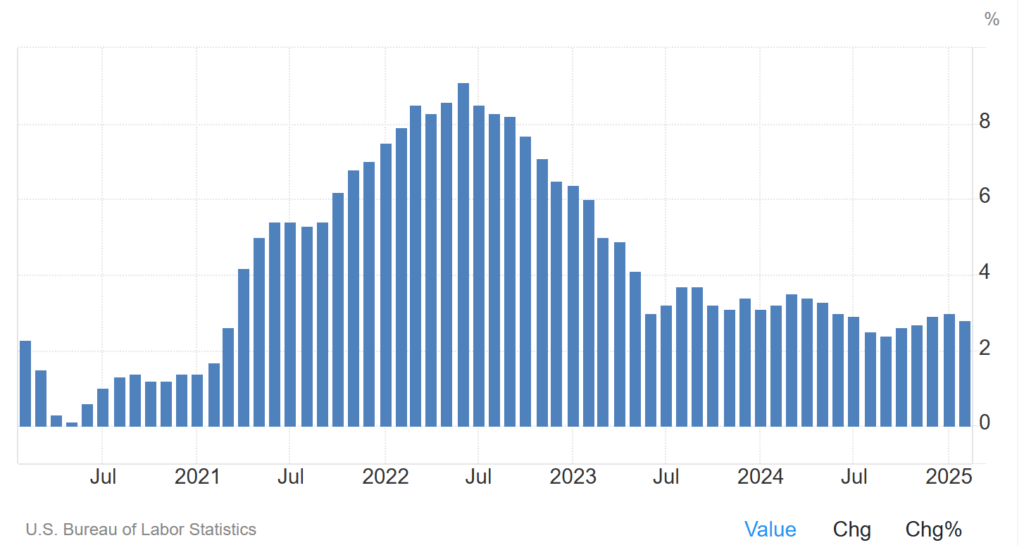
Third, the ballooning national debt looks troublesome and threatening in terms of size and in the face of higher interest rates (4.5% vs 0%). The US government spends more than it earns via tax collection. So, it has had to borrow through issuance of Treasuries and bonds to pay our collective bills. The national debt is the cumulative amount we’ve borrowed over time to pay those bills. Unfortunately, that amount has doubled over the past 15 years due to efforts to rescue the economy during the Great Recession (2007-2009) and more recently COVID pandemic (2020 – 2023). For historical context, the national debt-to-GDP ratio currently stands at ~99%. Only time when it was higher: post-WWII (106%.)
Here are key dangers posed by a large, growing national debt:
· We will have to make more sacrifices to rein it in.
· We will have less leeway in addressing crisis (e.g., recession, pandemic, conflict).
· We will have less money to invest in key industries (tech), defense, etc. This would leave our country more vulnerable to domestic and international threats.
As with most big problems, the solution is likely multi-pronged:
· Cut spending.
· Earn our way out of this quagmire by investing in new technology (AI), industries (green), etc.
· Pray.
Fourth, geopolitics has led to fierce competition and decoupling of economies, foremost being between the US (current superpower) and China (rising superpower). Globalization is being replaced by nationalism via protectionist policies: Biden’s small yard/high fence (technology); Trump’s tariff. Offshoring is being replaced with onshoring where the goods of cheaper international suppliers (China) are swopped for those of more expensive domestic producers (US). Although US-China competition remains predominantly in the economic sphere, if not managed well diplomatically, it could escalate into military conflict(s). (See Taiwan.) However, if managed well diplomatically, US-China competition could help spur both countries to greater innovation and productivity and, thereby, benefit the global economy as whole. (See game theory prisoner’s dilemma.)
Potential returns
Taoist believe the Universe is governed by opposing forces − yin and yang. This duality is seemingly reflected in markets as well. Risks in certain areas help highlight, if not set up, opportunities for returns in other areas.
First, the expensive US stock market makes the (US) bond market an increasingly attractive alternative in terms of risk (low) and return (equivalent to stocks). When one buys stocks, one becomes an owner of asset and, in return, receives dividends in the short-term and potentially higher appreciation of asset in the long-term…double profit. However, should one’s asset (company > stock) fail, as an owner, one would lose both dividends and principal (initial investment).
When one buys bonds, one becomes a lender of money and, in return, receives a certain amount of interest over a period of time (maturity). Lender usually has a lower chance of losing principal (initial investment). In a default, a lender is repaid before an owner. Also, the lender could assume the borrower’s assets as collateral.
Currently, since US stocks are very expensive (PE = 35 vs 16 historical average), future return is likely low, if not, negative. However, interest rate is comparatively high (~4.5% vs 2% historical average). So, one can easily get reasonable return for little to no risk by buying short-term treasuries, including TIPS (Treasury Inflation Protected Securities). For those with longer investment horizon (10 yrs or more), have higher risk tolerance and greater need for higher yields, a bond ladder in terms of maturity (short and intermediate) and varying issuance (government, state, corporations) may likely produce more stock-like returns (6-9%) with far less risk, including future interest rate movement. (See graph below “Fixed income returns given yield move scenarios.”)
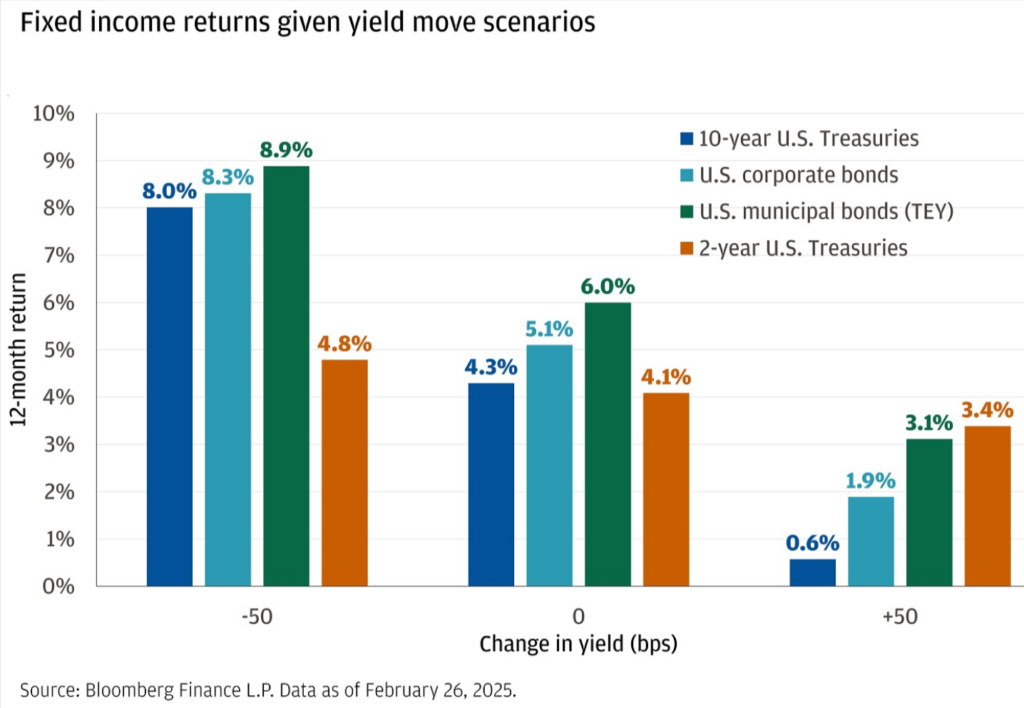
Second, to effectively outrun higher inflation (3.5%) over the long-term, one should consider a portfolio wherein the core holdings are US and international stocks. However, to lower risk and potentially increase return, one may consider tilting the portfolio towards cheaper areas. Domestically, this means large cap US value (PE = 17) and US small cap (PE = 17)]. Additionally, in a downturn, US large cap value could perform even better as a good portion of its holdings are in consumer staples (Proctor & Gamble – toilet paper, laundry detergent), healthcare and utilities. Such goods/services are non-discretionary; people need it regardless of the economic environment.
Internationally, having lagged the US for more than a decade now, the very cheap developed and emerging markets (PE = 14 and 13, respectively) seemingly offer even higher potential return. Should market leadership rotate, which seems to be taking place right now (US vs international stocks return −3.6% vs 9.4%, YTD ending March 19), lagging international stocks will likely lead in the coming years as was the case post-dot.com bubble.
Third, to hedge against the possibility that the US government can’t make repayments on the large (and growing) national debt (aka sovereign crisis), one may consider holding real assets, such as gold, energy (e.g., oil, natural gas) and/or commodities (e.g., metals, food stuff). Keep in mind, though. Gold’s value lies mostly in providing psychological comfort during a crisis. (It doesn’t produce anything.) As for energy and commodities, in a world facing climate change, prices could fluctuate widely due to erratic, if not decreasing, output. One would need a strong stomach to hold and (eventually) profit from these resources.
Fourth, although deglobalization may lead to higher prices, it may also offer the opportunity for greater diversification and lower risk. As countries and economies become more independent, they may also become less correlated. (When one zigs, the other zags.) A case in point is US and China. The decoupling process between these two super powers has spurred China (PE = 10) to increase investments in homegrown industries, such as (green) technology (e.g., EV cars, AI). Recent unveiling of DeepSeek, China’s equivalent to ChatGPT, suggest that it may become a viable rival for US tech dominance.
Since1978, China’s blistering growth (9% annual GDP) has helped lift about 800 million of its people out of poverty. (Respect!) However, the recent COVID-pandemic has revealed China’s deeper (economic) challenges: successfully transitioning from a manufacturing and real estate-led economy to an innovation (tech and green) and consumer-led economy. As with any growth journey, China will likely experience successes and set-backs as it works towards fulfilling its national ambition and vision. While uncertain and scary, the push-pull-dynamic of US-China competition offers investors a rare opportunity to diversify geographically and potentially profit from both large economies.
Final thoughts…
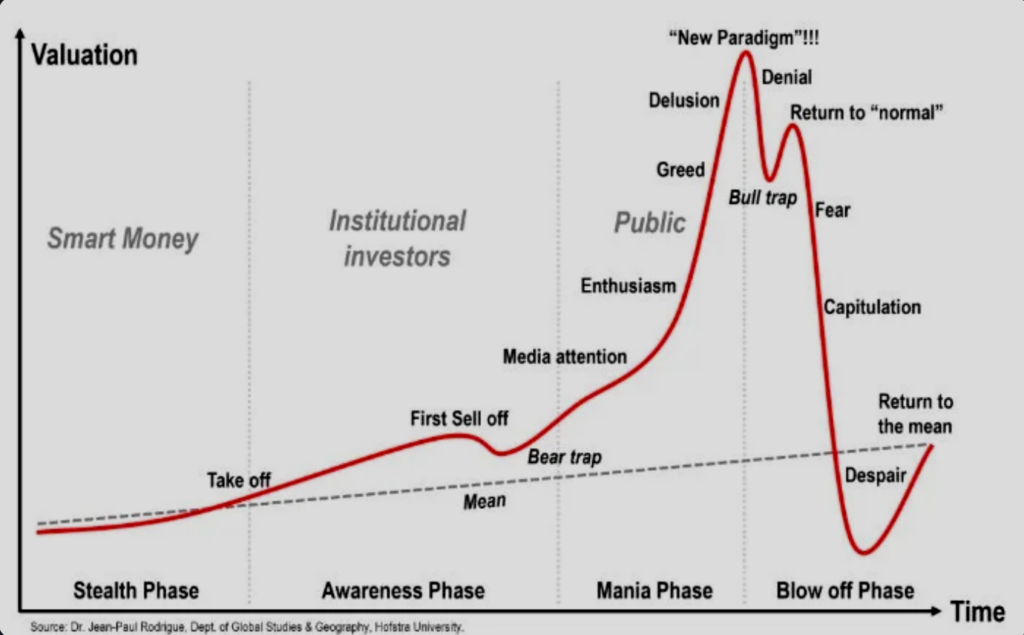
As shown in graph above, markets move in cycles: boom-bust-boom. Fueling such movements are a powerful combination of money and emotions. As investors, our main task is to try and determine where the market is in both respects, which is usually difficult. Only then can we have a better sense of how best to position our portfolio to lower the probability of permanent loss while increasing the probability of long-term gains.
As trite as it may sound, holding a balanced portfolio (appropriate asset allocation) relative to one’s risk tolerance, investment horizon and goals, is the greatest determinant of an investor’s success (90%). But, since markets continually move, risks and returns change over time sometimes quickly and sometimes slowly. To stay balanced we will have to rebalance periodically. With that said, however, steady and incremental changes are likely more effectively than hasty and wholesale.
In investing, it’s often said the most dangerous words are: “This time is different.” If that be the case, then perhaps the safest words are: “I could be wrong.” How one effectively balances hubris with humility, greed and fear, return and risk is the key to long-term success.
DISCLAIMER:
These are the general views and opinions of the author. Those who choose to implement on these views and opinions do so at their own discretion and risk.
RECENT POSTS
March 2025
Although 2024 double-digit stock market return suggests a strong US economy, the recent change in government leadership and policies highlights the underlying risk (uncertainty) that now weighs down the market and tests American exceptionalism.
December 2024
The fifth anniversary of my advisory firm and the holiday season have prompted me to reflect on my Life’s journey so far and, in so doing, unexpectedly arrive at an unconventional perspective on gifting.
October 2024
August steep market decline serves as a useful dress rehearsal for how we might react in a bear market and what we should do now to increase survival.
Get a free financial education.
Learn more about key financial topics, such as investing, 401k, disability insurance, paying for a home, at your own convenience. Sign up for Women’s Wealth monthly newsletter and have relevant information delivered to your inbox.

Live life on your own terms.
Do you find yourself constantly stressed or bored at work and wondering when you can live life on your own terms? Learn how to harness money’s energy and begin to create your life rather than manage it.
CONNECT
Anh Thu Tran
Women’s Wealth LLC
P.O. Box 1522
Tacoma, WA 98401
anhthu@womenswealthllc.com
(206) 499-1330
Women’s Wealth LLC is a Washington State registered investment advisor. The presence of this website on the Internet shall not be directly or indirectly interpreted as a solicitation of investment advisory services to persons of another jurisdiction unless otherwise permitted by statute. Follow-up or individualized responses to consumers in a particular state by our firm in the rendering of personalized investment advice for compensation shall not be made without our first complying with jurisdiction requirements or pursuant an applicable state exemption. For information concerning the status or disciplinary history of a broker-dealer, investment advisor, or their representatives, a consumer should contact their state securities administrator.
© 2025 Women’s Wealth LLC. All rights reserved. | Design by Erin Morton Creative, LLC.



